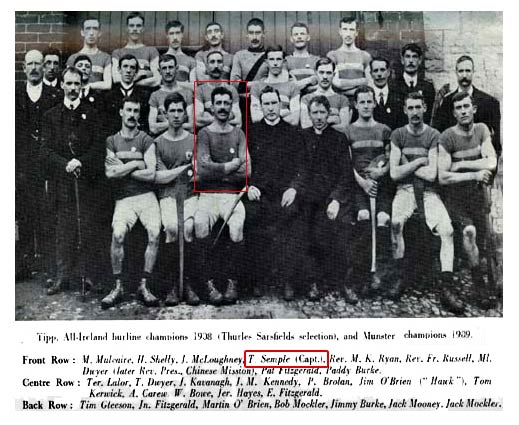A competition, whose aim is to promote hurling on an international basis and also promote Thurles Town and its environs as a tourist attraction, is being organised by Thurles Sarsfields, latter one of the oldest, most traditional and most successful clubs in Tipperary.
The hope is that all participants, supporters and visitors will enjoy the first ever international competition for a coveted prize, the Tom Semple Cup. The Tom Semple Cup has been donated by the Semple family, in memory of the great Tom Semple, whose name graces Munster’s finest stadium.
Tom Semple
(Click on Image for larger resolution)
Tom Semple (1879-1943), in hurling lore, is one of Irelands most famous sports persons. Born in The Glebe, Drombane, County Tipperary in 1879 Tom received a limited education at his local national school, and at the age of 16 he left his native Drombane, moving to Thurles where he worked as a guardsman with the Great Southern and Western Railway.
He played hurling with his local club Thurles “Blues” (Now Thurles Sarsfields) and with the Tipperary senior inter-county team from 1900 until 1912. He captained Tipperary to two All-Ireland titles in 1906 and 1908. He rose through the club serving as captain of the team for almost a decade. Semple captained the club to their first senior county title in 1904. Two years later in 1906, while still captain he captured a second county victory. These victories were to lead to the famous four-in-a-row for Thurles. Semple won an unprecedented eight county championship, with just two defeats for Thurles during his reign.
In 1910 Tom Semple and others organised a committee which purchased the showgrounds in Thurles, as part of their vision to develop a local hurling playing field. This field later became known as Thurles Sports-field and is regarded as one of the best surfaces for hurling in Ireland. In 1971 it was aptly renamed Semple Stadium in Tom’s honour, and is still referred to lovingly in some quarters as ‘Tom Semple’s field.’
Tom Semple also held the post of chairman of the Tipperary County Board and represented Tipperary, amongst other positions as treasurer, on the Munster Council and Central Council. Tom Semple’s grave can be visited here in St Mary’s Churchyard, beside St Mary’s Famine Museum here in Thurles.
Munster Final Day in Thurles holds a special place in the hearts of all devout hurling followers and organisers hope that all who visit here, will experience all that is spectacular about this great Irish cultural game, during this planned event. This competition is expected to takes place over this coming Munster Final weekend, and will be an annual event here in Thurles in the future, regardless of where Munster Finals are played. Indeed as organisers correctly state, with our modern road transport network in place and with a regular, fast public transport facilities servicing Thurles, followers of the sport are ever only 1.5 hours away from any likely future Munster Final venue.
The Teams Already Eagerly Signed Up
The teams already signing up to compete this year are Brussels, under Willie Cashin of Moycarkey-Borris. Kilburn Gaels will be managed by Moyne man Tom Bergin. One of the big names are Robert Emmets led ny Mick O’Dea of Liscarroll, Co Cork. The exclusive hurling club of Na Magha in Derry is taking part in its first international competition, led by Damian Doherty. The traditional Gaelic club of Keady from Armagh is under the watchful eye of Jim McCormack and have on occasion been coached by the Thurles Sarsfields’ senior coach, Paddy McCormack. Ger Collins, a former centre-forward with Thurles Sarsfields was involved in the setting up of a hurling club in Dundalk, Naomh Moninne. Co Kildare’s Naas are managed and coached by Pat English from Carlow and their secretary, former Watergrasshill hurler Brian O’Riordan. The Wild Geese from Lakenheath managed by Major Tim Neylon are representing the USA, and by competing will be the first US army team to take part in an official international competition.
This competition has all the promise of becoming the first fully international competition since the Tailteann Games of the twenties, latter a form of “Celtic Olympics” that originated in the 6th century BC, supposedly by Lugh, (Latter an Irish deity represented in mythological texts as a hero and High King of the distant past) and which were held continuously up until the 12th century AD, before being revived in the 1880’s and lapsing in the early 1920s. The first games were to be held in 1922, but the outbreak of our Civil War saw American athletes pull out, resulting in the games being abandoned. When revived two years later, the games were a runaway success, with over 5,000 competitors in disciplines as diverse as hurling and Gaelic football, a full athletics programme, swimming, motor-cycle and airplane racing, art and music competitions, attracted hundreds of thousands of people.


Leave a Reply